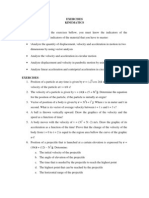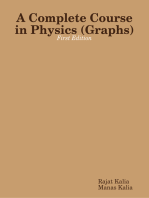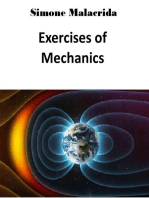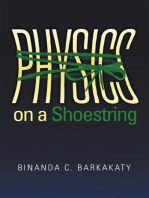Rot. Kinematics
Rot. Kinematics
Uploaded by
Nicolas Patrick OntiverosCopyright:
Available Formats
Rot. Kinematics
Rot. Kinematics
Uploaded by
Nicolas Patrick OntiverosCopyright
Available Formats
Share this document
Did you find this document useful?
Is this content inappropriate?
Copyright:
Available Formats
Rot. Kinematics
Rot. Kinematics
Uploaded by
Nicolas Patrick OntiverosCopyright:
Available Formats
1 Unit 11 ROTATIONAL KINEMATICS - Supplementary Problems 1.
A circular disk, starting from rest, rotates with an angular acceleration given by = (3 + 4t) rad/s2. a. Derive the expression for the angular speed as a function of time. [ = (3t + 2t2) rad/s] b. Derive the expression for the angle the wheel turns through as a function of time.
3 2 [ = 2 t + 3 t ] 2 3
c. Determine , , and at t = 2.0 seconds. [11 rad/s2, 14 rad/s, 34/3 rad] d. If the disk has a radius of 0.3 meter, determine the linear speed and the radial and tangential components of the linear acceleration of a point on the rim of the disk at t = 2.0 seconds. [vt = 4.2 m/s, ar = 58.8 m/s2, at = 3.3 m/s2]
2. A kid is standing on a Merry-Go-Round 5 meters from its axis of rotation. Starting from rest, the M-G-R accelerates uniformly. After 8.0 seconds its angular speed is 0.08 rev/sec. At 8.0 seconds find the kid's a. angular speed in rad/s. [0.5 rad/s] b. linear speed. [2.5 m/s] c. angular acceleration. d. centripetal acceleration. e. tangential acceleration. [0.063 rad/s2] [1.25 m/s2] [0.32 m/s2]
m, v 4 x 3 y
3. A particle of mass m is moving along the x-axis as shown with speed v. All quantities are in SI units. a. At the instant the particle's coordinates are (4, 0), find its angular - 4 momentum relative to points (0, 0); (0, 3); and (0, -4). [0, 3mv k , - 4mv k ] y b. At the instant the particle is at (4,0), a force (F )k is acting on 2 the particle. At this instant, determine the torque on the -3 particle relative to the points listed in (a). i j i [4F( j ), F (3 4 ) , 4F( j )]
v3
v2
v 4
4. At a particular instant three particles, all of mass m, are located r r i j i at (4, 0), (0, 2), and (-3,0) and have velocities v1 = v( + ) , v 2 = 2v , and r v = v(3 4 j ), respectively. All quantities are in SI units. Find the total angular i
3
momentum of the system relative to the origin.
[12mv k ]
2 Unit 11 ROTATIONAL KINEMATICS - Supplementary Problems
0
(a, 0)
5. A particle of mass m is dropped from point (a, 0) and falls parallel to the vertical y-axis because of gravity. With respect to the origin, a. find the torque acting on the particle at time t. [mga, into page] b. find the angular momentum of the particle at time t. [mgat, into page] r r c. Show that = dL / dt is true for this situation.
m -y
6. A dumbbell consists of two small 0.4 kg masses attached to the ends of a 1.0 meter rod of negligible mass. The dumbbell rotates about a fixed vertical axis with an angular speed of 3/4 rev/sec in the three different arrangements shown below.
For each case, relative to the axis of rotation, determine a. the angular momentum of mass #1 b. the angular momentum of mass #2 c. the total angular momentum of the dumbbell r r r L1 = L2 = 0.47 kg m2/s and Ltotal = 0.94 kg m2/s, all directed up toward the top of the page [A: r r r L1 = 0, L1 = 1.88 kg m2/s and Ltotal = 1.88 kg m2/s, all directed up toward the B:
top of the r page r
r L1 = L2 = 0.24 kg m2/s and Ltotal = 0.47 kg m2/s, all directed up toward the C:
top of the page]
7. A gyroscope precesses with its axis in a horizontal plane as shown at the right. The wheel is a uniform disk of radius R, mass M, and is rotating in the direction shown with an angular speed . The magnitude of the angular momentum of the disk is given by L = (MR2/2). Its precessional angular speed is /16. Assuming the mass of the axle to be negligible, a. show that = 8 g / R . r b. determine the direction of the precessional angular velocity, .
You might also like
- Physics I Final Cheat SheetDocument1 pagePhysics I Final Cheat SheetJsea2011100% (1)
- Circular MotionDocument18 pagesCircular Motiongert16No ratings yet
- Chapter 7-Rotational MotionDocument59 pagesChapter 7-Rotational MotionSuganeya UdiasoorianNo ratings yet
- AssignmentDocument9 pagesAssignmentAhmad KhanNo ratings yet
- Rotational MotionDocument54 pagesRotational MotionMohammed Aftab Ahmed100% (3)
- Rotatory Motion: Previous Eamcet QuestionsDocument17 pagesRotatory Motion: Previous Eamcet QuestionsAnonymous LTsNUndNo ratings yet
- Angular MotionDocument21 pagesAngular Motionsuperman618No ratings yet
- Ch09 SSM 070904Document26 pagesCh09 SSM 070904VinhTranNo ratings yet
- Circular MotionDocument8 pagesCircular MotionGreg Eleftheriou0% (1)
- Mechanicsssssss ExamplesDocument9 pagesMechanicsssssss ExamplesJhonrey Joey DesabilleNo ratings yet
- Circular MotionDocument18 pagesCircular MotionDilip Kumar RaiNo ratings yet
- Rotational MotionDocument112 pagesRotational Motionriyanshi1612No ratings yet
- GyroscopeDocument7 pagesGyroscopeRajesh SarkarNo ratings yet
- Rotational MotionDocument7 pagesRotational MotionJhon Erik IgnacioNo ratings yet
- Extra Physics Rotational ProblemsDocument4 pagesExtra Physics Rotational ProblemsjohnnyNo ratings yet
- PHY 400 - Chapter 6 - Rotational MotionDocument30 pagesPHY 400 - Chapter 6 - Rotational MotionJacob OrtizNo ratings yet
- Physics Grade 11 Unit Six Summary: Angular Motion /rotational Motion/ By:Addis Ababa Education Bureau MAY 2020Document42 pagesPhysics Grade 11 Unit Six Summary: Angular Motion /rotational Motion/ By:Addis Ababa Education Bureau MAY 2020Sun TechNo ratings yet
- G15 - Dynamics - Curilinear Motion - Polar Coordinates - ProblemsDocument17 pagesG15 - Dynamics - Curilinear Motion - Polar Coordinates - ProblemsAlfredo Ruiz ValenciaNo ratings yet
- Curvilinear MotionDocument22 pagesCurvilinear MotionRjay FloresNo ratings yet
- Sr. No. Practical 1: Static and Dynamic Balancing of Rotating MassesDocument21 pagesSr. No. Practical 1: Static and Dynamic Balancing of Rotating MassesFa CaNo ratings yet
- Kinematics of Rotation of Rigid BodiesDocument10 pagesKinematics of Rotation of Rigid BodiesWong SunNo ratings yet
- A2 41b CircularmotionDocument38 pagesA2 41b CircularmotionHany ElGezawyNo ratings yet
- Module 1Document17 pagesModule 1robejr2013No ratings yet
- Chapter 10: Rotation 10.1: What Is Physics?: Translational MotionDocument9 pagesChapter 10: Rotation 10.1: What Is Physics?: Translational MotionSaqr HattabNo ratings yet
- Phy303k HW2, CH1Document4 pagesPhy303k HW2, CH1Charles YamashiroNo ratings yet
- 15 Angular Momentum-ProblemsDocument3 pages15 Angular Momentum-ProblemsMichael Kevin YangNo ratings yet
- Angular MotionDocument4 pagesAngular MotionmikezewelanjisinyangweNo ratings yet
- G12 Relative Velocity Relative AccelerationDocument48 pagesG12 Relative Velocity Relative AccelerationSilas LargosBalonesNo ratings yet
- Rotational Motion NotesDocument9 pagesRotational Motion NotesTvissha GoelNo ratings yet
- NCERT Solutions For Class 11 Physics Chapter 7 System of Particles and Rotational MotionDocument32 pagesNCERT Solutions For Class 11 Physics Chapter 7 System of Particles and Rotational Motionerfgtrgv vfvvvNo ratings yet
- JEE Mains Q.bank Circular MotionDocument63 pagesJEE Mains Q.bank Circular MotionTapankumar Sanyal50% (4)
- AP PhysicsDocument27 pagesAP PhysicsJoao Figueiredo100% (1)
- Exercises For KinematicsDocument2 pagesExercises For KinematicsMaria Laksmi SarestriNo ratings yet
- fypANG, ENGR 62, StanfordDocument35 pagesfypANG, ENGR 62, StanfordsuudsfiinNo ratings yet
- PHYS 1120 Rotational Kinematics SolutionsDocument7 pagesPHYS 1120 Rotational Kinematics SolutionsEnger AlingasaNo ratings yet
- Physics 1120: Rotational Kinematics SolutionsDocument7 pagesPhysics 1120: Rotational Kinematics SolutionsNykia Bhelle Lansangan CarpioNo ratings yet
- Rotation Theory IIDocument21 pagesRotation Theory IIMohammed Aftab AhmedNo ratings yet
- Reminders: and Dynamics) - Questions!)Document24 pagesReminders: and Dynamics) - Questions!)Bosco BeloNo ratings yet
- Igcse Sample PaperDocument8 pagesIgcse Sample PaperharshanauocNo ratings yet
- 14 Rolling and Energy-ProblemsDocument5 pages14 Rolling and Energy-ProblemsMichael Kevin YangNo ratings yet
- Homework #10 SolutionsDocument3 pagesHomework #10 SolutionsMarco ConopioNo ratings yet
- Physics Chapter 11Document18 pagesPhysics Chapter 11cryptachrisNo ratings yet
- P11 Practice 6 SolnsDocument10 pagesP11 Practice 6 SolnsajjagottuNo ratings yet
- Rigid Body Dynamics - Chap 16Document60 pagesRigid Body Dynamics - Chap 16Na2ryNo ratings yet
- Rotational Motion-1Document30 pagesRotational Motion-1muddu00007No ratings yet
- Chapter 11fallDocument35 pagesChapter 11fallEdgarNo ratings yet
- QB Em2 TempDocument18 pagesQB Em2 Tempanshu kushwahNo ratings yet
- Orca Share Media1698314208316 7123246077197692067Document27 pagesOrca Share Media1698314208316 7123246077197692067ClaiireNo ratings yet
- Circular Motion: Unit 6Document20 pagesCircular Motion: Unit 6Nurul Afida TahirNo ratings yet
- Rotational ProblemDocument10 pagesRotational Problemursml12No ratings yet
- Ch15 ReviewDocument3 pagesCh15 ReviewHeimer SantosNo ratings yet
- 6 Uniform Circular MotionDocument83 pages6 Uniform Circular MotionRamachandranPerumal0% (1)
- Solution 1Document33 pagesSolution 1deepanshsahu01No ratings yet
- Phy - G 11-CH-6Document17 pagesPhy - G 11-CH-6Metiku DigieNo ratings yet
- Rotational Motion Part-BDocument25 pagesRotational Motion Part-Bsmi_santhosh100% (1)
- Circular MotionDocument47 pagesCircular MotionNaksh bhatiNo ratings yet
- Applications of Derivatives Rate of Change (Calculus) Mathematics Question BankFrom EverandApplications of Derivatives Rate of Change (Calculus) Mathematics Question BankNo ratings yet
- 92 CDocument7 pages92 CNicolas Patrick OntiverosNo ratings yet
- Problems 12Document3 pagesProblems 12Nicolas Patrick OntiverosNo ratings yet
- Equil. #1Document1 pageEquil. #1Nicolas Patrick OntiverosNo ratings yet
- Rot Dynamics PG 3-4Document3 pagesRot Dynamics PG 3-4Nicolas Patrick OntiverosNo ratings yet
- Rot Dynamics PG 1-2Document4 pagesRot Dynamics PG 1-2Nicolas Patrick OntiverosNo ratings yet
- MOM.A (Key)Document2 pagesMOM.A (Key)Nicolas Patrick OntiverosNo ratings yet
- Wk&EnergyDocument4 pagesWk&EnergyNicolas Patrick OntiverosNo ratings yet
- WS09 1Document3 pagesWS09 1Nicolas Patrick OntiverosNo ratings yet
- AP Worksheet 4.3 - PROJECTILE MOTIONDocument3 pagesAP Worksheet 4.3 - PROJECTILE MOTIONNicolas Patrick OntiverosNo ratings yet
- AP Worksheet 4.2 - PROJECTILE MOTION: Max o 2Document3 pagesAP Worksheet 4.2 - PROJECTILE MOTION: Max o 2Nicolas Patrick OntiverosNo ratings yet
- Carroll, Sean - Woven From Weirdness (New Scientist, 14 Sept. 2019)Document5 pagesCarroll, Sean - Woven From Weirdness (New Scientist, 14 Sept. 2019)Pamela ChapmanNo ratings yet
- Fma 2018 A Solutions PDFDocument20 pagesFma 2018 A Solutions PDFparas jainNo ratings yet
- Rr10302 Applied MechanicsDocument12 pagesRr10302 Applied MechanicsSRINIVASA RAO GANTANo ratings yet
- Rec8 SolutionsDocument3 pagesRec8 SolutionsctrlqazNo ratings yet
- Crew Day MasterDocument36 pagesCrew Day Masterc130fe55No ratings yet
- Physics by Shailendra Sir: Fnyyh OkysDocument4 pagesPhysics by Shailendra Sir: Fnyyh OkysShailendra SinghNo ratings yet
- QB Sol NLM ForceDocument21 pagesQB Sol NLM Forceagrawalayush040No ratings yet
- MAY2003P3MSDocument17 pagesMAY2003P3MSlifeinacsNo ratings yet
- Pendulum With Moving SupportDocument6 pagesPendulum With Moving SupportLuis OcañaNo ratings yet
- Tangential and Centripetal Acceleration - Chapter 7.2Document23 pagesTangential and Centripetal Acceleration - Chapter 7.2Hafiezul HassanNo ratings yet
- 9th Class English Medium Full Book NotesDocument52 pages9th Class English Medium Full Book NotesZafar Iqbal ChannarNo ratings yet
- Class 9 Science Mark Type Questions - CH - 7 - MOTIONDocument27 pagesClass 9 Science Mark Type Questions - CH - 7 - MOTIONSiddhartha PramanickNo ratings yet
- Seiko Radio Sync Solar User ManualDocument27 pagesSeiko Radio Sync Solar User ManualOscar SalazarNo ratings yet
- 3 Laws of Motion Lesson Plan - KODIGODocument5 pages3 Laws of Motion Lesson Plan - KODIGODaniel LorioNo ratings yet
- Causality, Chance, and Law Mario BungeDocument18 pagesCausality, Chance, and Law Mario BungeADRIAN CASTRO RUIZNo ratings yet
- 7 Motion and TimeDocument4 pages7 Motion and Timesmi_santhoshNo ratings yet
- Motion in Two Dimensions - CeLOEDocument24 pagesMotion in Two Dimensions - CeLOEMuhammad GustianNo ratings yet
- Conservation of Mechanical EnergyDocument7 pagesConservation of Mechanical EnergyNica DacumosNo ratings yet
- Kinematics Test W SolutionsDocument5 pagesKinematics Test W SolutionsNicholas ChevalierNo ratings yet
- Physics Mcqs Ist Year - Junaid KhanDocument2 pagesPhysics Mcqs Ist Year - Junaid KhanJunaid KhanNo ratings yet
- Physics Coursework 2016/2017 STPMDocument13 pagesPhysics Coursework 2016/2017 STPMShi JieNo ratings yet
- Ela Black Holes EssayDocument4 pagesEla Black Holes Essayapi-551895403No ratings yet
- 6 - Translation and Rotation of Liquid Masses PDFDocument13 pages6 - Translation and Rotation of Liquid Masses PDFFrenz VillasisNo ratings yet
- The Pulley and Belt System PDFDocument9 pagesThe Pulley and Belt System PDFslayz0879100% (1)
- Distance Time Velocity SEmDocument7 pagesDistance Time Velocity SEmIZ - 12JR 1013186 Lincoln Alexander SSNo ratings yet
- Work, Power and EnergyDocument4 pagesWork, Power and EnergyJeya Plays YTNo ratings yet
- 100 MCQ of PhysicsDocument48 pages100 MCQ of PhysicsFarah Anjum72% (36)
- Science-9-QUARTER 4Document64 pagesScience-9-QUARTER 4Quinto Jaypee Seinsei75% (8)
- 043 Naskhah Kawapan Sains DLP T4 Fasa3-237-258Document22 pages043 Naskhah Kawapan Sains DLP T4 Fasa3-237-258DARANISAI A/P RAVI MoeNo ratings yet



































































































